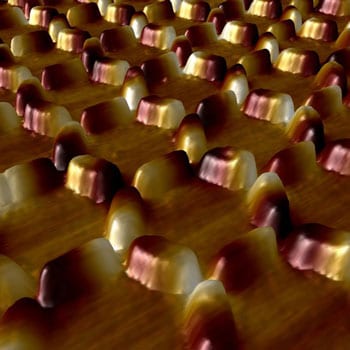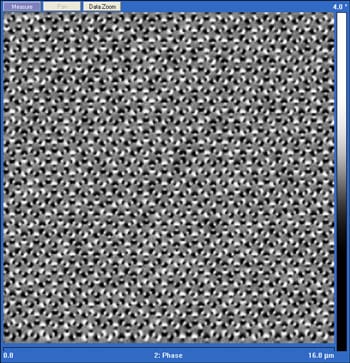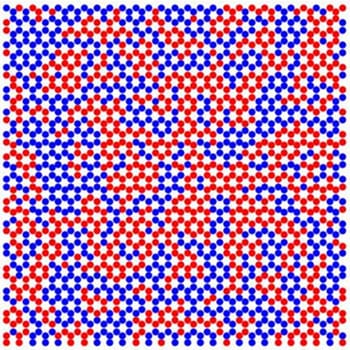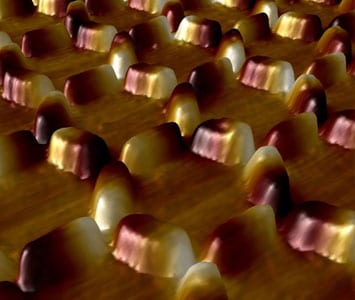A team of scientists could directly visualize magnetic charge crystallization in an artificial spin ice material, a first in the study of a relatively new class of frustrated artificial magnetic materials-by-design known as artificial spin ice. These charges are analogs to electrical charges with possible applications in magnetic memories and devices; in describing this class of materials, the new work demonstrates their utility.
Los Alamos National Laboratory staff scientist Cristiano Nisoli explained, “Magnetic technology generally concerns itself with manipulation of localized dipolar degrees of freedom.” He continued: “The ability of building materials containing delocalized monopolar charges is very exciting with possible technological implications in data storage and computation.”

A 3-D depiction of the honeycomb artificial spin ice topography after the annealing and cooling protocols. The light and dark colors represent the north and south magnetic poles of the islands. Image: I. Gilbert, U. of I.
“The emergence of magnetic monopoles in spin ice systems is a particular case of what physicists call fractionalization, or deconfinement of quasi-particles that together are seen as comprising the fundamental unit of the system, in this case the north and south poles of a nanomagnet,” Nisoli said. “We have seen how arranging magnets in a honeycomb configuration allows for these charges to be sort of ‘stripped’ from the magnetic islands to which they belong and become relevant degrees of freedom.”
The unique properties of spin ice materials have fascinated scientists since they were first discovered in the late 1990s in naturally occurring rare earth titanites. The material is aptly named: the highly complex ordering of nanoscale magnets in spin ice obey the same rules that determine the positional ordering of hydrogen and oxygen atoms in frozen water ice. Both have “spin”—degrees of freedom—with frustrated interactions that prevent complete freezing, even at absolute zero.
In 2006, an interdisciplinary team of physicists and materials scientists designed the first artificial spin ice, a two-dimensional array of magnetic nanoislands that are fabricated to interact in complex ways, depending on the chosen design of the array. The islands were lithographically printed onto a substrate, arranged in a square-lattice pattern, with the north and south poles of each nanomagnet meeting and interacting at their four-pronged vertices.
Now the same research team has developed a new annealing protocol that allows the artificial material’s full potential for highly complex magnetic interactions to be realized. The new protocol was applied to two artificial spin ice materials, one configured in a square-lattice pattern, the other in a hexagonal-honeycomb pattern with three-pronged vertices.

Magnetic force microscope image of emergent domains of ordered magnetic charges in honeycomb artificial spin ice. The black and white dots in the image are the north and south magnetic poles of the nanomagnets. Image: I. Gilbert, U. of I.
In the honeycomb pattern, where three magnetic poles intersect, a net charge of north or south is forced at each vertex. The magnetic “monopole charge” at each vertex influences the magnetic “charge” of the surrounding vertices. The team was able to image the crystalline structure of the magnetic charges using magnetic force microscopy.
University of Illinois physicist Peter Schiffer, who led the team, explained, “Nanomagnets are so small that their behavior becomes relatively simple. We can arrange the magnets in a particular lattice pattern—square or honeycomb—and they interact in a way that we can predict and control.”
Schiffer added, “The challenge—you have to get the nanomagnets to flip their north and south poles to show how they interact. It’s hard to force them to show the effects of interaction, since they get stuck in one particular arrangement.”
The research team’s new annealing protocol—heating the material to a high temperature where their magnetic polarity is suppressed (here, about 550 degrees Celsius) —allows the nanomagnets to flip their polarity and freely interact. As the material cools, the nanomagnets are ordered according to the interactions of their poles at the vertices.

A map of the crystallites of ordered magnetic charges in honeycomb artificial spin ice. The red and blue dots correspond to vertices belonging to each of the two degenerate magnetic change-ordered states. Image: I. Gilbert, U. of I.
The collective thermal behavior of the arrays is studied through statistical mechanics, a branch of fundamental physics. As theorized, the monopole charge of each vertex was found to contribute to the order of the entire system in a manner analogous to the interactions of electric charges at the atomic scale during water ice crystal growth.
An advantage of artificial spin ice is that it can be designed in different topologies, and examined subsequently to see the effects of those topologies. That allows physicists to explore a wide range of possible behaviors that are not accessible in natural crystals.
“This work demonstrates a direction in condensed matter physics that is quite opposite to what has been done in the last six decades or so,” said Nisoli. “Instead of imagining an emergent theoretical description to model the behavior of a nature-given material and validating it indirectly, we engineer materials of desired emergent properties that can be visualized directly.”
Source: LANL

















